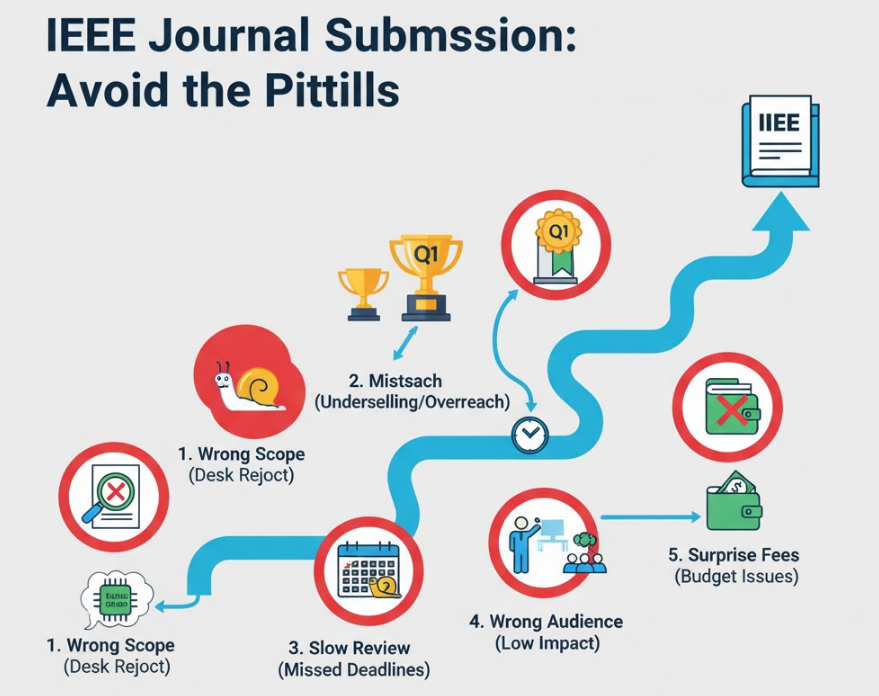Publishing in an IEEE journal is a hallmark
of quality and a significant achievement for any engineer or computer
scientist. With hundreds of prestigious publications to choose from, selecting
the right journal for your manuscript is one of the most critical
decisions you will make.

Choosing incorrectly can lead to a
frustrating cycle of desk rejections, wasted time, and your work failing to
reach its intended audience. This is not a simple submission guide; it's a
"pitfall guide" designed to help you navigate the five most common
mistakes researchers make when selecting an IEEE journal.
1. The Pitfall: Ignoring the "Aims
& Scope"
This is the #1 reason for immediate desk
rejection. You have a brilliant paper on antenna design, but you submit it to a
journal focused on power electronics. It will be rejected within days, not
because of its quality, but because it's in the wrong place.
How to Avoid It:
- Read Beyond the Title: A journal's
title can be broad. You must meticulously read the "Aims &
Scope" or "About the Journal" section on the IEEE Xplore
page for that specific publication.
- Analyze the Details: Does the
journal focus on theoretical contributions or practical applications? What
specific sub-topics are listed?
- Scan Recent Articles: Browse the
table of contents of the last few issues. Do the titles and abstracts of
the published papers look like yours? This is the ultimate litmus test.
2. The Pitfall: Misjudging the Journal's
Prestige and Impact
Submitting a groundbreaking, novel paper to
a lower-tier journal means you are underselling your work. Conversely,
submitting an incremental study to a top-tier journal like the Proceedings
of the IEEE is a near-certain rejection.
How to Avoid It:
- Check Key Metrics: Look up the
journal's key performance indicators. The two most important are:
- Journal Impact Factor (JIF): Found
in Clarivate's Journal Citation Reports (JCR).
- CiteScore: Found on Scopus.
- Understand Quartile Rankings (Q1-Q4): These metrics rank a journal relative to others in its field.
A "Q1" journal is in the top 25% by Impact Factor, signifying
high prestige.
- Assess Community Reputation:
Metrics aren't everything. Ask your supervisor and senior colleagues:
"What are the most respected journals in our specific
sub-field?" Their experience is invaluable.
3. The Pitfall: Overlooking the Review
and Publication Speed
You need a publication for a grant
application or a graduation deadline, but you've submitted to a journal with a
notoriously long review cycle. The average time from submission to first
decision can vary from a few weeks to over a year.
How to Avoid It:
- Look for Stated Timelines: Many
journal homepages now provide metrics like "Average time to first
decision" or "Submission to acceptance."
- Research the Journal's Reputation:
Some IEEE journals are known for their speed (e.g., fully open access
journals like IEEE Access often have review cycles of 4-6 weeks).
Others, particularly older, highly specialized journals, can be much
slower. Search for author experiences online or ask peers.
- Align with Your Needs: Be
realistic. If your conference is in early 2026, submitting to a journal
with a 12-month average review time in October 2025 is a high-risk
strategy.
4. The Pitfall: Disregarding the Target
Audience
Publication is fundamentally about
communication. Your paper might be brilliant, but if it's published in a
journal that your target audience doesn't read, its impact will be severely
limited.
How to Avoid It:
- Consider the Readership: Who reads
this journal? Is it primarily for academics, or does it have a strong
readership among industry professionals and practicing engineers?
- Match Theory with Practice: If your
paper is highly theoretical, a journal focused on foundational research is
a better fit than one focused on practical applications, and vice versa.
- Check Your Own References: Look at
your paper's bibliography. Where are the authors you are citing publishing
their work? This is a strong indicator of the right community and the
right journals to target.
5. The Pitfall: Getting Trapped by
Publication Fees
You receive an acceptance letter, only to
be followed by an invoice for an Article Processing Charge (APC) of $2,000 USD
that your funding cannot cover.
How to Avoid It:
- Understand the Journal Type:
- Traditional (Subscription): No fee
to publish. The journal is funded by library subscriptions.
- Hybrid: A traditional journal that
gives you the option to make your individual article open access
by paying an APC.
- Fully Open Access: All articles
require an APC upon acceptance.
- Check the "For Authors" Page for APCs: Before you submit, find the section on author fees and know
the exact cost. Ensure you have the funding available. This simple check
can save you from a very difficult situation later.
Conclusion
Choosing the right IEEE journal is a
strategic decision that is just as important as the research itself. By
avoiding these five common pitfalls, you can save yourself months of wasted
time and frustration, ensure your paper is reviewed by the right experts, and
ultimately, maximize the impact of your valuable work.


